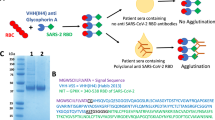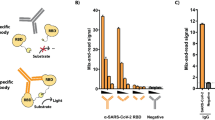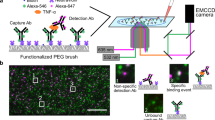Abstract
THE detection of humoral antibody can only be adequately assessed by using techniques which are solely dependent on the primary interaction of antigen and antibody1–5. Two such primary measures of antibody detection are the Farr technique6 and radioimmunoelectrophoresis7. Radioimmunoelectrophoresis is an extremely sensitive test which is dependent on the specific activity of the labelled antigen. It is, however, qualitative, whereas the Farr technique is a quantitative test to determine either the capacity of an antiserum to bind the antigen6 or the amount of antibody8,9 the antiserum contains. Recently, the sensitivity of the Farr technique has been questioned, especially with respect to the detection of 19S antibody10. The work reported here shows that 19S antibody can readily be detected by the Farr technique only if an appropriate concentration of antigen is used to achieve maximum sensitivity of the method.
This is a preview of subscription content, access via your institution
Access options
Subscribe to this journal
Receive 51 print issues and online access
$199.00 per year
only $3.90 per issue
Buy this article
- Purchase on Springer Link
- Instant access to full article PDF
Prices may be subject to local taxes which are calculated during checkout
Similar content being viewed by others
References
Grey, H. M., Immunology, 7, 82 (1964).
Dressman, G., Larson, C., Pinckard, R. N., Groyon, R. M., and Benedict, A. A., Proc. Soc. Exp. Biol. and Med., 118, 292 (1965).
Freeman, M. J., and Stavitsky, A. B., J. Immunol., 95, 981 (1965).
Minden, P., Reid, R. T., and Farr, R. S., J. Immunol., 96, 180 (1966).
Benedict, A. A., Nature, 206, 1368 (1965).
Farr, R. S., J. Infect. Dis., 103, 239 (1958).
Yagi, Y., Maier, D., and Pressman, D., J. Immunol., 89, 736 (1962).
Mulligan, J. J., Osler, A. G., and Rodriguez, E., J. Immunol., 96, 324 (1966).
Osler, A. G., Mulligan, J. J., and Rodriguez, E., J. Immunol., 96, 334 (1966).
Wei, M.-M., and Stavitsky, A. B., Immunology, 12, 431 (1967).
Pinckard, R. N., Weir, D. M., and McBride, W. H., Clin. Exp. Immunol., 2, 331 (1967).
Weir, D. M., Pinckard, R. N., Elson, C. J., and Suckling, D. E., Clin. Exp. Immunol., 1, 433 (1967).
Rosenquist, G. L., and Gilden, R. V., Biochim. Biophys. Acta, 78, 543 (1963).
Hunter, W. M., and Greenwood, F. C., Nature, 194, 495 (1962).
Author information
Authors and Affiliations
Rights and permissions
About this article
Cite this article
PINCKARD, R., McBRIDE, W. & WEIR, D. Sensitivity and Detection of 19S Antibody by the Farr Technique. Nature 215, 1084–1085 (1967). https://doi.org/10.1038/2151084a0
Received:
Issue Date:
DOI: https://doi.org/10.1038/2151084a0
Comments
By submitting a comment you agree to abide by our Terms and Community Guidelines. If you find something abusive or that does not comply with our terms or guidelines please flag it as inappropriate.



